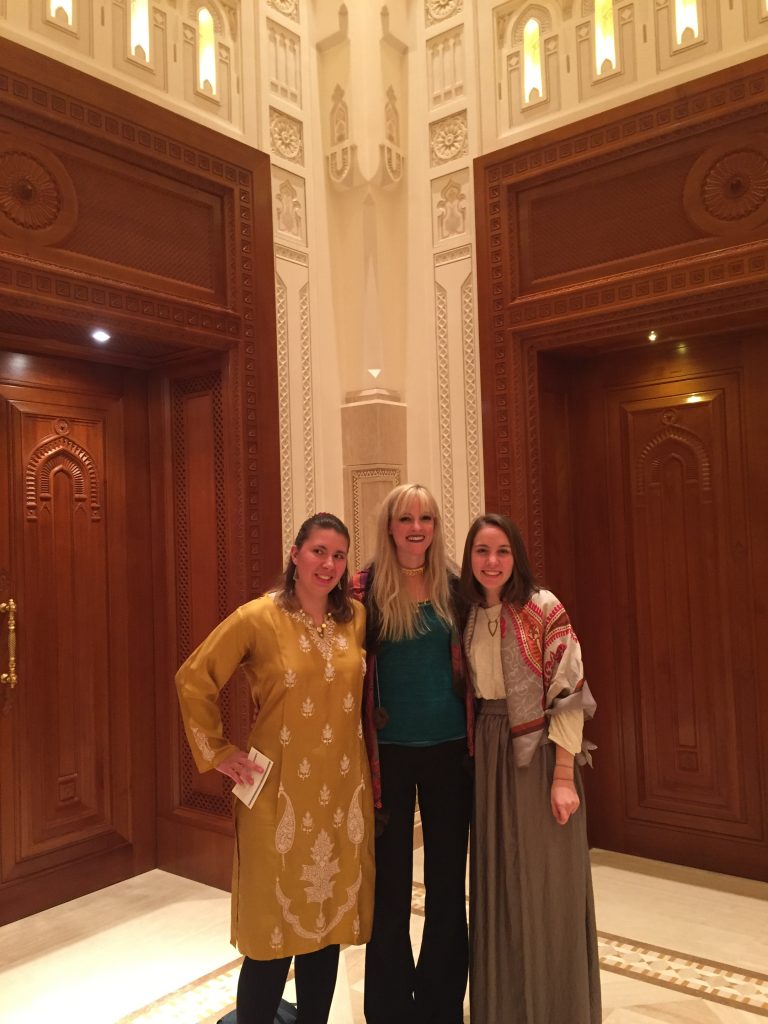
When I packed for my adventure abroad, I went for the practical hiking clothes, clothes to cover up and the comfiest t-shirts I could find for lounging around our home. What I did not anticipate were the glittering gowns and long stunning skirts I would find venturing around the market. In the middle of this rocky desert landscape, there is so much glamour, and I have found the center of it all: The Royal Opera House in Muscat.
Our lovely resident seminary student and musician Laurel encouraged our group to join her at the Opera last week. The show: “The Fifteen top Classical Arab Songs”. My first thought: what will I wear? While the boys went shopping in the Souq and got fitted for dishdashas—the traditional menswear of Oman– my roommate Jessica and I ruffled through our stuff deciding what to wear. Jessica selected a gold caftan that she had bought the week prior and I pulled out a skirt, a cotton top and the fanciest scarf I had thrown in before I left. It would have to do.
When we arrived at the Opera, we walked into the lobby and immediately were met with an architectural gem. From floor up, white and gold accented details danced until they reached a wood-paneled ceiling with hand-painted designs. Around us, men draped in spotless white dishdashas and topped with brightly wrapped Musalas strutted about as women’s skirts sashayed over their strappy high heels.
The front of the theatre glittered as lights danced off long silver pipes. His Majesty Sultan Qaboos bin Said comes often to the Opera for organ concerts and the center of the space is devoted to the beloved instrument. In front of the organ on the stage were seats set for a full orchestra. We sat in our seats and waited watching people chatter and the ushers leading guests throughout the theatre. After a while, the lights dimmed and the concert began.
The orchestra silently marched on stage, men in tuxedos and white bow ties and women in red and green garb with beautiful, gold headdresses. The conductor bowed and took his place. Then, the first singer, Jahida Wehbe arrived on stage in a stunning sheer green draped dress with gold accents. When she opened her mouth to sing, a stream of Arabic flowed out and she held notes I wish I knew how to reach.
Drums deep and low set the undertones, the flutes twinkled their tunes, and the strings sang along. The singer performed with great control using her arms to gesture on the fast-paced Arabian journey. The woman next to me in her sparkling black and silver wrap was wiping her eyes during the lullabies and clapping along to the marching melodies. The audience’s attention and their hearts went especially for the next singer Ali Al Haggar as he went on in deep vibrato.
Drums deep and low set the undertones, the flutes twinkled their tunes, and the strings sang along.
What started as a one hundred thirty-minute show quickly became a three-hour event as Ali offered encore after encore. Women swung their gold bangled arms and cheered to the songs as the orchestra carried on. By the end of the night, I was exhausted, but the atmosphere kept my eyes wide. The traditional tunes are still much loved here, and I am so lucky I got to hear them from the best of the best: the Royal Oman Symphony Orchestra.
Check out the Opera site: https://www.rohmuscat.org.om/en and Ali Al Haggar (I couldn’t film during the show) here.










